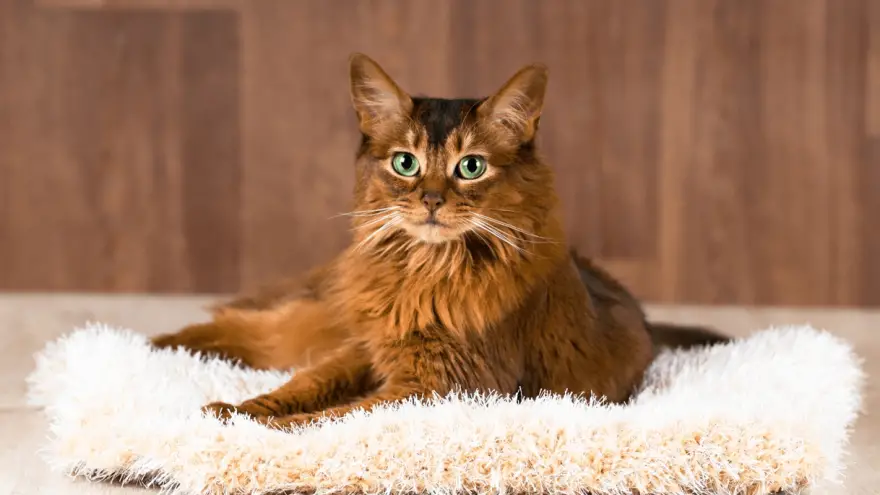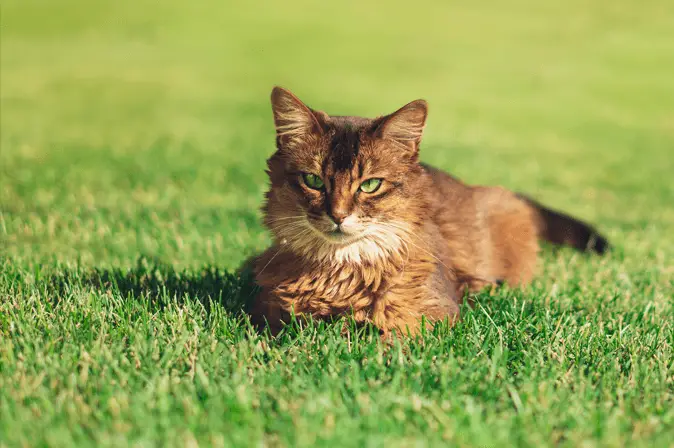
Somali
The Somali should be crowned the king of all cats if you ask us. This breed looks like a tiny lion. We are absolutely in love with the Somali’s appearance, and it seems like we’re not alone. These cats became pretty popular across the globe, which isn’t that surprising if you take a closer look at these fantastic felines. If you’re looking for a fantastic new companion that will make every moment enjoyable, you should seriously consider getting one of these cats. Here’s what all cat lovers need to know about these fantastic cats.

Length:
11–14 in

Weight:
6-10 lb

Origin:
USA

Life Expectancy:
11-16 years
Breed History
We cannot talk about the history of the Somali breed without mentioning the history of the Abyssinian. The Somali and the Abyssinian are related, and the Somali is practically a longhaired version of the Abyssinian. In North America, New Zealand, and Australia, exported Abyssinians occasionally produced longhaired offspring. In 1963, Mary Mailing, a Canadian cat breeder, entered one of those kittens in a cat show. Judging her group was Ken McGill, a judge who immediately got interested in the longhaired cat and asked for one for breeding purposes. Other Canadian breeders got involved, and they all decided to develop the breed. One breeder started calling the longhaired kittens “Somalis,” and the breed took off. It received recognition in 1979, and 14 years later, international recognition followed.
Cat Breed Characteristics
You’ll notice so many different things even at your first glance of the Somali. These cats have bushy tails, large, almond-shaped eyes, and large, pointy ears. All of these things make a unique and beautiful appearance. Here are the most dominant characteristics we will focus on.
Coat
The first thing we absolutely have to mention is the Somali’s coat. These cats have one of the softest coats in the feline kingdom. If you ever get the chance, pet one of these cats, and you will feel for yourself. They are one of the best cuddling partners out there.

Coat color
The Somali has a unique coat color. Each of its individual hair can contain between 4 and 20 colors. Different registries accept different colors, but the most common ones are ruddy, red, blue, fawn, ruddy silver, red silver, blue silver, and fawn silver.
Size
The cat’s size should be important to future Somali owners. You don’t want to end up with a cat you don’t have enough space for. The Somali is considered a medium-sized cat. Most adult cats weigh 6 - 10 pounds and reach a length of 11 - 14 inches (without the tail).
Temperament
While the physical appearance of a cat is important, the thing that will make it a great pet is its temperament. This is a highly intelligent cat, just like the Abyssinian. That makes them really fun to have around the home, but it also makes them very challenging to raise. Their minds need to be engaged and challenged. You will have to make sure they live in a challenging environment. They are pretty active and love to play, climb, and explore. The Somali will form a strong bond with its owners, and it usually picks a single person they will give most of their attention to. They are also very adaptable, so they will thrive in various homes if they have plenty of love and affection.
Health
The selective breeding of the Somali managed to eradicate different hereditary diseases. Unfortunately, it didn’t eliminate all of them. No matter which breed you have at home, chances are, there are potential health issues they might be prone to. In Somali’s case, those issues are;
- Early periodontal disease - Oral hygiene is crucial for this breed, so make sure you and your vet keep an eye on your cat’s teeth.
- Progressive retinal atrophy - A hereditary eye condition that can lead to blindness.
- Pyruvate kinase deficiency - An inherited hemolytic anemia that is passed down from parents to offspring.
- Renal amyloidosis - This condition causes the amyloid protein to deposit in the cat’s organs, mainly Abyssinian’s kidneys.
- Patellar luxation - A hereditary dislocation of the kneecap. It can be severe, or it can be mild. The severity will determine the need for veterinary attention.
- Hyperesthesia syndrome - This syndrome causes the cat to act frantically when someone touches or pets them. It will also cause the cat to “overgroom” themselves and cause hair loss.
World Cat Finder Team

Updated at22.12.2021.

Share